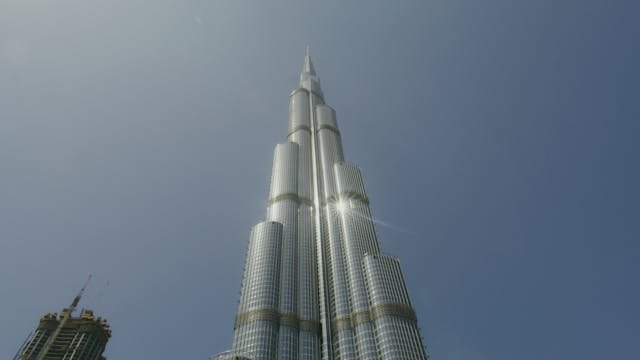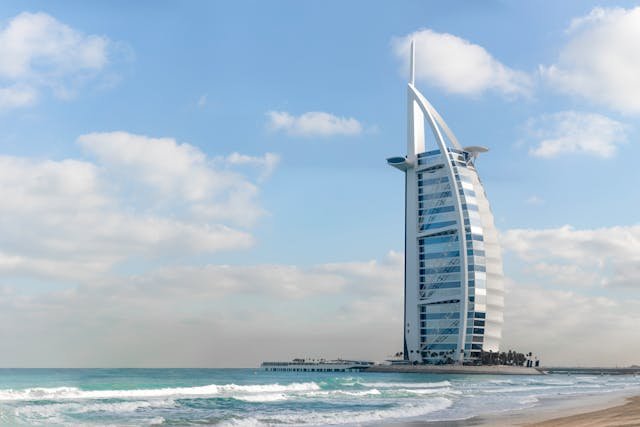Dubai is a city that seamlessly combines traditional and super-modern styles. This city gives tourists a great range of experiences, from tall buildings to the expansive desert environment. It’s a dynamic place with something for everyone, be it a love of luxury or cultural landmarks, or adventurous activities. Now let’s look at some of the best places to visit in Dubai.
Table of Contents
Burj Khalifa: World’s Tallest Building
No trip to Dubai would be complete without visiting the Burj Khalifa, the world’s tallest building. It is an iconic structure standing at 828 meters that reflects Dubai’s ambitiousness. These observation decks are called At The Top and The Top SKY situated on floors 124th and 148th respectively can be reached by taking an elevator ride where visitors can enjoy panoramic views of the city, desert, and Persian Gulf. For example, one can visit this place during sunset when there are the most beautiful golden lights in the city.

Dubai Mall: Best Places to Visit in Dubai
Dubai Mall, which lies next to Burj Kalifa, is a place where shopping enthusiasts and people looking for fun go to. It boasts of over 1,200 stores selling products from top fashion brands to globally known commodities thus being one of the largest malls in the world. However, it is not only a shopping hub; Dubai Aquarium and Underwater Zoo, VR Park, an ice rink indoors, and restaurants that cater to all tastes are located within its premises. Dubai Mall is a place you cannot miss whether you aspire to or only have window-shopping desires.
The Dubai Fountain: Best Places to Visit in Dubai
Dubai Fountain which is situated at the foot of Burj Khalifa and adjacent to Dubai Mall is regarded as the biggest music fountain on this planet. Consisting of water jets rising as high as 150 meters and dancing according to different genres ranging from classic songs to contemporary music amid a combination of lights and sounds; it looks like magic. You can watch it best from either the Waterfront promenade or by sitting on an ordinary abra (boat) stationed at Burj Lake. The shows happen every thirty minutes in the evenings providing an ideal late-night activity post shopping or meals.
Palm Jumeirah: The Icon of Man-Made Islands
A palm-shaped Palm Jumeirah represents one of Dubai’s most iconic and ambitious pieces of engineering. Luxury hotels, posh restaurants, and stylish beach clubs are found on this man-made island that constitutes an artificial archipelago. One of the highlights is Atlantis The Palm. It incorporates Aquaventure Waterpark and The Lost Chambers Aquarium. To see the island from a different perspective, make use of Palm Jumeirah Monorail or speedboat around its outer crescent. At the tip of the island lies Pointe, which is a waterfront destination offering dining as well as entertainment with amazing views towards Atlantis.
Dubai Marina: Contemporary Waterfront Wonderland
Dubai Marina is a vibrant waterside residential district that epitomizes modern living. It brings together eateries for food, shopping spots, and entertainment against a backdrop of towering buildings and luxury yachts. Visitors can take a leisurely walk along the Marina Walk, have a meal at any of the numerous waterfront restaurants, or go on a yacht cruise to view the skyline from the water level. Beach activities and outdoor shopping are also popular at JBR (Jumeirah Beach Residence) located nearby and at The Walk too.
Dubai Creek: Old Dubai’s Heart.
If you are interested in knowing more about the history of Dubai, you can visit Dubai Creek. It is a natural saltwater inlet that divides the city into two parts – Deira and Bur Dubai. Best explored by riding on a traditional dhow or abra across the waterway, this is where Old Dubai resides. At Bur Dubai side is the Al Fahidi Historical Neighborhood which is composed of wind-tower houses, museums, and art galleries connected by countless narrow alleyways. The Museum of Dubai located at Al Fahidi Fort provides an overview of how the city has changed from a small fishing village to a global metropolis.
Adventure in the Desert: Dubai Safari
Notably, no trip to Dubai would be complete without venturing into the vast desert that engulfs the city. This safari is filled with a lot of adventure starting from dune bashing in 4x4s to camel riding, sandboarding, and quad biking. A typical safari will end by stopping at a Bedouin-style camp where you can enjoy local Arabic food, henna painting, and live cultural performances like belly dance and Tanoura. The starkness of the desert’s beauty and its timelessness makes it an experience one can’t forget.
The Dubai Frame: Connecting Old Dubai with New Dubai
The Dubai Frame is a distinctive architectural landmark that offers a real frame for visitors to view both old and new parts of Dubai. Being 150 meters tall, the frame is found in Zabeel Park with panoramic views from its glass bridge on top. Downtown modern skyline can be seen on one side while older sections of the city are visible on the other side as well. It is particularly popular with photographers, especially during sunset when the cityscape looks golden.
Jumeirah Mosque: A Glimpse into Islamic Culture
Dubai has only a few mosques that allow non-Muslims to enter. Visiting Jumeirah Mosque is a good opportunity for tourists to learn about Islam and Arab culture. It is lit up at night and it looks really great. Visits to the mosque are offered by the Sheikh Mohammed Centre for Cultural Understanding which also organizes guided tours through other cultural sites in Dubai giving explanations on how these fit in with the way of life of Muslims there. Dressing modestly will prevent you from embarrassing yourself and women who forget to cover their heads can borrow scarves.
Al Fahidi Historical Neighborhood: A Journey Through Time
One of the oldest parts of Dubai, Al Fahidi Historical Neighborhood, also called Al Bastakiya, provides an insight into its history. Narrow streets are lined with traditional wind-tower houses, art galleries, museums, and cozy little cafés. The Coffee Museum exhibits regional coffee history and culture while visitors can engage in cultural activities such as eating traditional meals at the Sheikh Mohammed Centre for Cultural Understanding among others. Exploring this area is best done during guided walking tours.
Dubai Miracle Garden: A Floral Wonderland
Dubai Miracle Garden is a colorful, vibrant oasis in the heart of the desert with over 150 million flowers artistically arranged in various complex patterns and themes. The garden opens during the cool months from November to April and it is a local favorite as well as a tourist one. They include Emirates A380 floral installation which happens to be the largest of its kind globally and heart-shaped arches for perfect photo sessions. With varying designs of the garden, there is always something new every season.
Global Village: A Cultural Extravaganza
For half a year, Global Village guests witnessed cultures from all over the world coming together under one roof. It operates between October and April and has pavilions representing different nations showcasing their wares, traditional crafts, and cultural performances. Visitors can enjoy different international dishes at street food stalls while watching live performances or even shopping for souvenirs from almost any country globally. Global Village is a family-friendly outing because it has an energetic atmosphere coupled with diversity in offerings.
Dubai Opera: A Cultural Icon
Anyone who enjoys the performing arts cannot afford to miss Dubai Opera. Located in Downtown Dubai, this opera house is an example of modern architecture modeled after a traditional dhow. The place serves as a venue for numerous performances such as opera, ballet, concerts, and dramas. Thus, whether you are attending a world-class function or just admiring the beautiful architectural design of the building itself; you will have added some cultural substance to your itinerary. It is therefore important to check the schedule beforehand and book tickets ahead of time since popular shows usually go on sale quickly.
Conclusion
Dubai unites culture with technology and its pasts blend well with the future to form a city full of contrasts. From the towering heights of Burj Khalifa to calm waters in Dubai Creek offering an array of experiences ideal for every traveler. If looking for luxurious living, adventure, culture, or simply a change from normal routine then Dubai has something for everyone. As such, get your travel bags ready because this amazing destination awaits you with stunning places that must be visited within Dubai.
Frequently Asked Questions
- When is the best time to visit Dubai?
Dubai is at its best between November and March when temperature conditions are cooler and more suitable for outdoor activities.
- How long should I stay in Dubai?
To fully experience the major highlights of Dubai, it is advised that you spend between 4-5 days in the city.
- Do tourists need to follow any dress code while visiting Dubai?
Even though Dubai is more liberal compared to other places in this region, it would be better if one observed modest dressing when they are out in public, especially around religious sites and traditional areas.
- Is Dubai safe for a single traveler?
Yes! It is considered one of the safest cities with minimal crime rates and good tourism infrastructures that are well established.
- Can I see both modern and historical attractions in Dubai?
Definitely! You can find them both. For example, you can visit the Al Fahidi Historical Neighborhood or go up the Burj Khalifa.





